
The Noble–Seymour–Crippen House is a mansion located at 5624 North Newark Avenue in Chicago's Norwood Park community area. Its southern wing, built in 1833, is widely considered the oldest existing building in Chicago.
Claude Vautrin House is a historic home and farm complex located at Cape Vincent in Jefferson County, New York. The limestone farmhouse is a two-story structure with a square main block with a hipped roof and a one-story wooden rear wing with a gable roof, built in 1855 in the Italianate style. Also on the property are six contributing 19th century outbuildings: a barn with a silo, four sheds, and a smokehouse.

The Boyd–Wilson Farm is a 157-acre (64 ha) historic district in Franklin, Tennessee, United States. The circa 1840 farm includes an I-house.
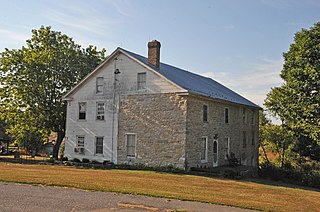
Strode-Morrison-Tabler House and Farm is a historic home located near Hedgesville, Berkeley County, West Virginia. It is a farmhouse of brick, limestone, and wood construction that began in 1752 as a single-story, side-gable, two-bay cottage of rubble limestone that subsequently underwent several additions during the 19th century. These additions include a brick upper story added to the original house and a three-bay, limestone addition constructed about 1830. This limestone addition became the principal section of the house. A wood-frame addition was built along the rear of the house by the end of the 19th century. Also on the property are four sheds / outbuildings, a garage, and barn complex.

The Jacob Arndt House and Barn is a historic home and Pennsylvania barn located at 910 Raubsville Road in Williams Township, Northampton County, Pennsylvania. The land on which the home sits was inherited by Jacob Arndt from his father, Abraham, in 1795.
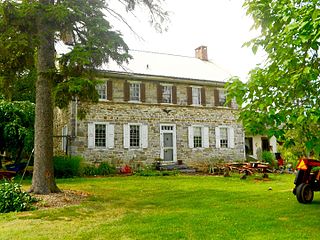
The George Wilson Homestead is an historic home which is located in Halfmoon Township, Centre County, Pennsylvania.
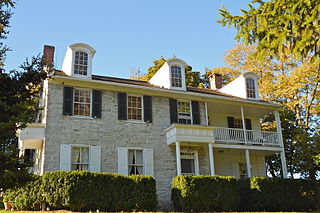
The Ashton-Hursh House is a historic home and outbuilding located at 204 Limekiln Road in Fairview Township, York County, Pennsylvania. Built in stages between approximately 1764 and 1830, it is a 2+1⁄2-story, "L"-shaped, Federal style log, frame, and stone dwelling. Situated on a limestone foundation, the home also has a gable roof and three Greek Revival-style porticos. The frame outbuilding may date as early as 1734; it was renovated circa 1830. The outbuilding is believed by historians to be York County's oldest occupied structure.

The James Finley House, also known as the Commanding Officer's Residence, is an historic American home that is located at the Letterkenny Army Depot in Greene Township in Franklin County, Pennsylvania.
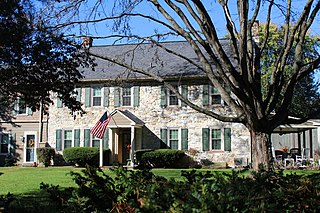
The Jacob Keller Farm, also known as the Covered Bridge Inn-Bed and Breakfast, is an historic American home and grist mill located in Ephrata Township, Lancaster County, Pennsylvania.
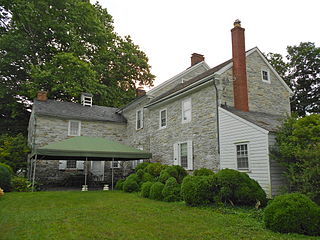
The Hibshman Farm, also known as the Schantz Farm, is an historic home and farm complex which is located in Ephrata Township, Lancaster County, Pennsylvania.

The John Immel House was an historic farmhouse that was located in Jackson Township, Lebanon County, Pennsylvania.

The Squire Cheyney Farm is an historic, American farm and national historic district that is located in Thornbury Township, Chester County, Pennsylvania.

The Wee Grimmet is an historic, American home that is located in Whitford, West Whiteland Township, Chester County, Pennsylvania.

The Joseph Gregg House is an historic home that is located in Kennett Township, Chester County, Pennsylvania.
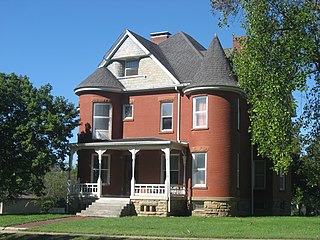
The Chalon Guard and Emma Blades Cloud House is a historic house located at 300 S. Washington St. in McLeansboro, Illinois. The house was built circa 1892 for Chalon Guard Cloud, who ran the Cloud State Bank with his father Aaron, and his wife Emma Blades Cloud. The house's design features a distinctive blend of architectural styles; while primarily designed in the Queen Anne style, it also includes elements of the Shingle and Romanesque styles. The house is built of red brick with a limestone foundation; the brick masonry walls of the house are characteristic of Richardsonian Romanesque architecture and represent the only residential use of the style in McLeansboro. Two conical turrets mark the front corners of the house; two other turrets are located on the south side of the home. A large roof gable, which connects to the top of the smaller southern turret, is sided in slate-colored shingles typical of the Shingle Style. The house's front porch, which was added in the early 20th century, features turned columns and a spindlework railing. The house's multi-component roof features several cross gables and three brick chimneys.

The Townsend Farm is a historic farmstead on East Harrisville Road in Dublin, New Hampshire. Built about 1780 and enlarged about 1850 and again at the turn of the 20th century, it is one of Dublin's older houses, notable as the home and studio of artist George DeForest Brush, one of the leading figures of Dublin's early 20th-century art colony. The house was listed on the National Register of Historic Places in 1983.

The John and Amelia McClintock House is a historic building located at 321 E. Main Street in Grafton, Illinois. Boat builder John McClintock built the house for his family circa 1910. The rock-faced concrete house, an unusual departure from Grafton's limestone buildings, has a Queen Anne design. The entrance is located at the corner of a wraparound front porch and is topped by a conical roof. The front of the house has a cutaway bay, giving the house an asymmetrical appearance, and the gable roof has multiple components; both features are typical of Queen Anne designs. The building is now used as a commercial property.

The Black Homestead Farm is a historic farm located west of Carrollton in Greene County, Illinois. Margaret Black, one of the county's first settlers, established the farm in 1821. The farmhouse, built two years later, is the oldest surviving house in Greene County. Architect William Reay designed the brick Federal house, which features a symmetrical plan with evenly spaced windows, an oval fanlight above the original main entrance, and a gable roof with chimneys at each end. A new entrance with a Greek Revival porch was placed on the house in 1855. Other 19th-century farm buildings on the property include a smokehouse, wash house, carriage house, and horse barn. The farm raised livestock and grew grain through the 19th and 20th centuries, as was typical of Greene County farms; it still has active corn and soybean crops.
The Tiger-Anderson House is a historic farmhouse located west of Springfield, Illinois on County Road 3 North. The Greek Revival house was built circa 1832. The two-story brick house has an "L"-shaped plan. The front entrance is located in the center of the main wing; it features a transom with engaged piers, sidelights on either side, and a flat lintel. Both the main wing and rear ell are topped by gable roofs. Moses K. Anderson, who served as Illinois' adjutant general for eighteen years, lived in the house from 1868 to 1881.
The W.T. Ford House is a historic residence located south of Earlham, Iowa, United States. This early example of a vernacular limestone farmhouse was built in three parts. The first section of the house is attributed to George Francis, who was one of the first settlers in the township. This 1+1⁄2-story section is composed of rubble limestone. The first addition was built onto the south side of the original house. It is also 1+1⁄2 stories and it is composed of locally quarried finished cut and ashlar limestone. Most of the main facade of this addition has a full-sized enclosed stucco porch.




















